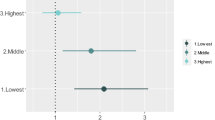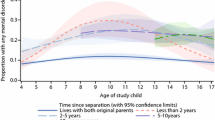Summary
The relationship between family support variables and child mental disorders was assessed through a prevalence study conducted in an urban neighborhood of Bahia, Brazil. From a representative sample of 828 children, aged between 5 and 14 years, 23.3% were diagnosed as having varying degrees of psychological symptoms. Diagnoses were based on psychiatric interviews, following screening using the Questionário de Morbidade Psiquiátrica Infantil (QMPI). Results supported the hypotheses that: (a) children from smaller families exhibit a higher prevalence than those from larger families; (b) prevalence of neurotic and psychosomatic disorders is lower for children from larger families than for those from smaller ones. The data failed to confirm the hypothesis that family type is associated with the occurrence of psychopathology in children. Controlled analyses indicated that these relationships were not confounded by the age or sex of the child, the social class, type or size of the family.
Similar content being viewed by others
References
Almeida Filho N de (1981) Development and assessment of the QMPI: Brazilian children's behavior questionnaire for completion by parents. Soc Psychiatry 16: 205–210
Baldassare M (1979) Residential crowding in urban America. University of California Press, Berkeley
Bossard JHS, Boll ES (1956) The large family system. University of Pennsylvania Press, Philadelphia
Cassel J (1971) Health consequences of population density and crowding. In: National Academy of Sciences. Rapid population growth: consequences and policy applications. Johns Hopkins Press, Baltimore
Cassel J (1973) The relationship of the urban environment to health: implications for prevention. Mt Sinai J Med 40: 539–450
Cassel J (1976) The contribution of the social environment to host resistance. Am J Epidemiol 104: 107–123
Chombart de Lauwe P (1960) Famille et habitation. Editions du CNRS, Paris
Christensen HT (1968) Children in the family: relationship of number and spacing to marital success. J Marriage Family 30: 283–280
Ellis A, Beechley RM (1951) A comparison of child guidance clinic patients coming from large, medium, and small families. J Gen Psychol 79: 131–144
Hassan R (1977) Social and psychological implications of high population density. Civilisations 28: 228–242
Hawkes GR, Burchinal L, Gardner B (1958) Size of family and adjustment of children. Marriage Family Living 20: 65–68
Hendricks LE (1977) The effects of family size, child spacing and family density on stress in low income black mothers and their preadolescent children. Unpublished Doctoral Dissertation, University of North Carolina, Chapel Hill
Kaplan E, Cassel J, Gore S (1977) Social support and health. Med Care 15: 47–58
Kleinbaum D, Kupper L (1979) Advanced methods in epidemiology (EPI 268). University of North Carolina School of Public Health, Chapel Hill, NC (Mimeo)
Landis PH (1954) Teenage adjustments in large and small families. Washington State University Agricultural Experiment Stations. Bulletin No. 549
Leighton DC (1972) Measuring stress levels in school children as a program-monitoring device. Am J Publ Health 62: 799–804
Nuttall RL, Nuttall EV, Sweet PR (1971) Correlates of family size and expected family size among Puerto Rican youth. The Institute of Human Sciences at Boston College, Chestnut Hill, MA
Nye FI (1952) Sibling number, broken homes and adjustment. Marriage Family Living 14: 327–330
Nye FI (1958) Family relationships and delinquent behavior. Wiley and Sons, New York
Pugliese C (1969) Piano de desenvolvimento comunitario do nordeste de Amaralina. Anals, Seminario ABEM, Sao Paulo
Rutter M (1972) Maternal deprivation revisited. Penguin Press, Baltimore
Rutter M, Lebovici S, Eisenberg L, Snezneuskij A, Sadoun R, Brooke E, Lin T (1969) A tri-axial classification of mental disorders in childhood: an international study. J Child Psychol Psychiatry 10: 41–61
Santana V (1978) Estudo de epidemiologia das doencas mentais em um bairro de Salvador: Nordeste de Amaralina. Unpublished Master's Thesis, University of Bahia
Schmitt RC (1966) Density, health and social disorganization. J Am Inst Planners 20: 273–283
Spence JC, Wallon WS, Miller FJW, Court SDM (1954) A thousand families in Newcastle-Upon-Tyne. Oxford University Press, London
Suepsaman B (1973) The study of stress in Thai children: an epidemiological study of Thai children in Bankok, Thailand. Unpublished Doctoral Dissertation, University of North Carolina, Chapel Hill
Templeton JA (1962) Influence of family size on some aspects of teen-agers' attitudes, behavior and perceptions of home life. Family Life Coordinator 3: 51–57
Touliatos J, Lindholm BW (1980) Birth order, family size, and children's mental health. Psychol Reports 46: 1097–1098
Tuckman J, Regan RA (1967) Size of family and behavior problems in children. J Gen Psychol 111: 151–160
Author information
Authors and Affiliations
Additional information
This research was supported by the Masters Program in Community Health of the University of Bahia and by the Rockefeller Foundation.
Rights and permissions
About this article
Cite this article
de Almeida-Filho, N. Family variables and child mental disorders in a third world urban area (Bahia, Brazil). Soc Psychiatry 19, 23–30 (1983). https://doi.org/10.1007/BF00583858
Accepted:
Issue Date:
DOI: https://doi.org/10.1007/BF00583858




